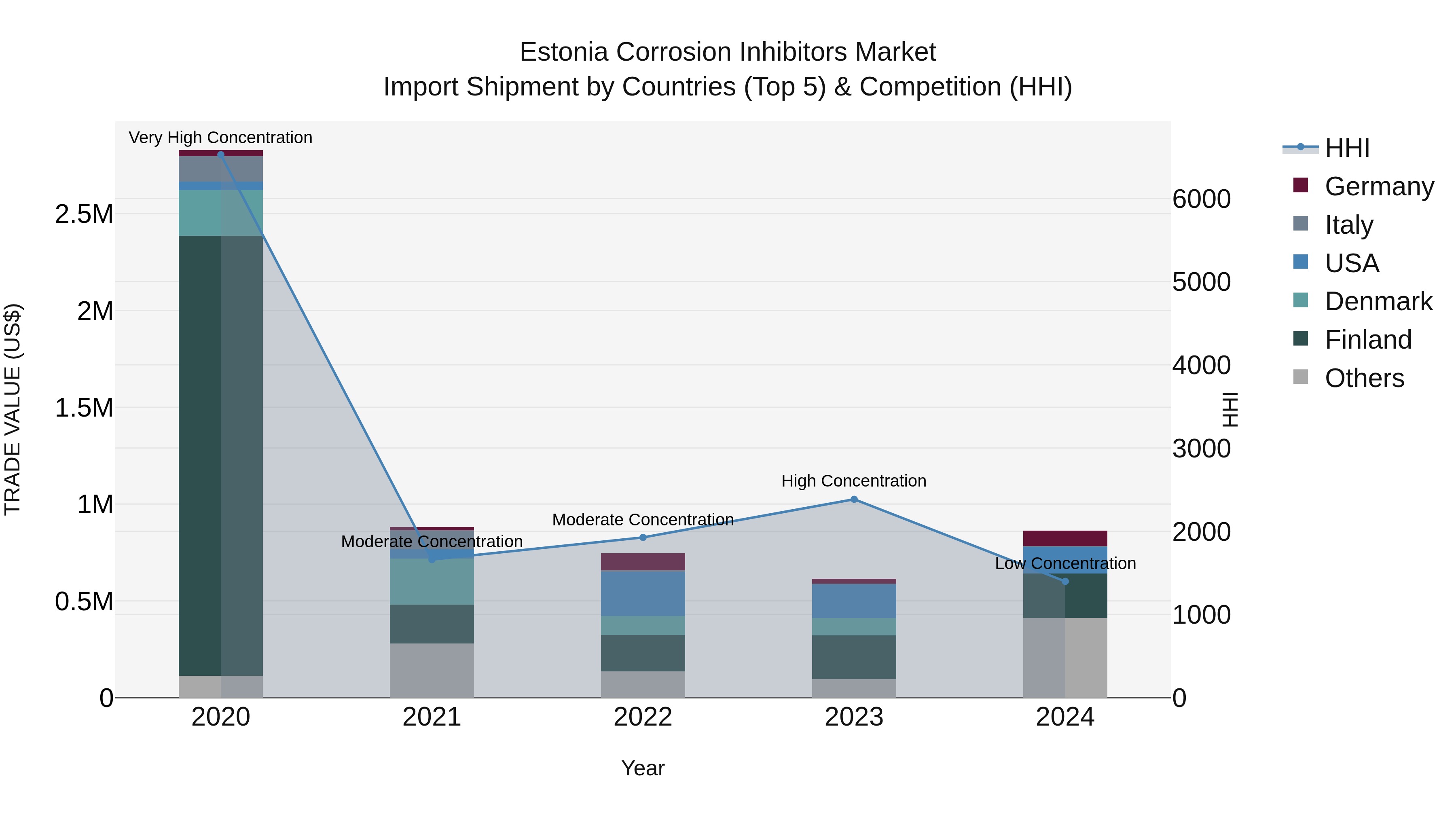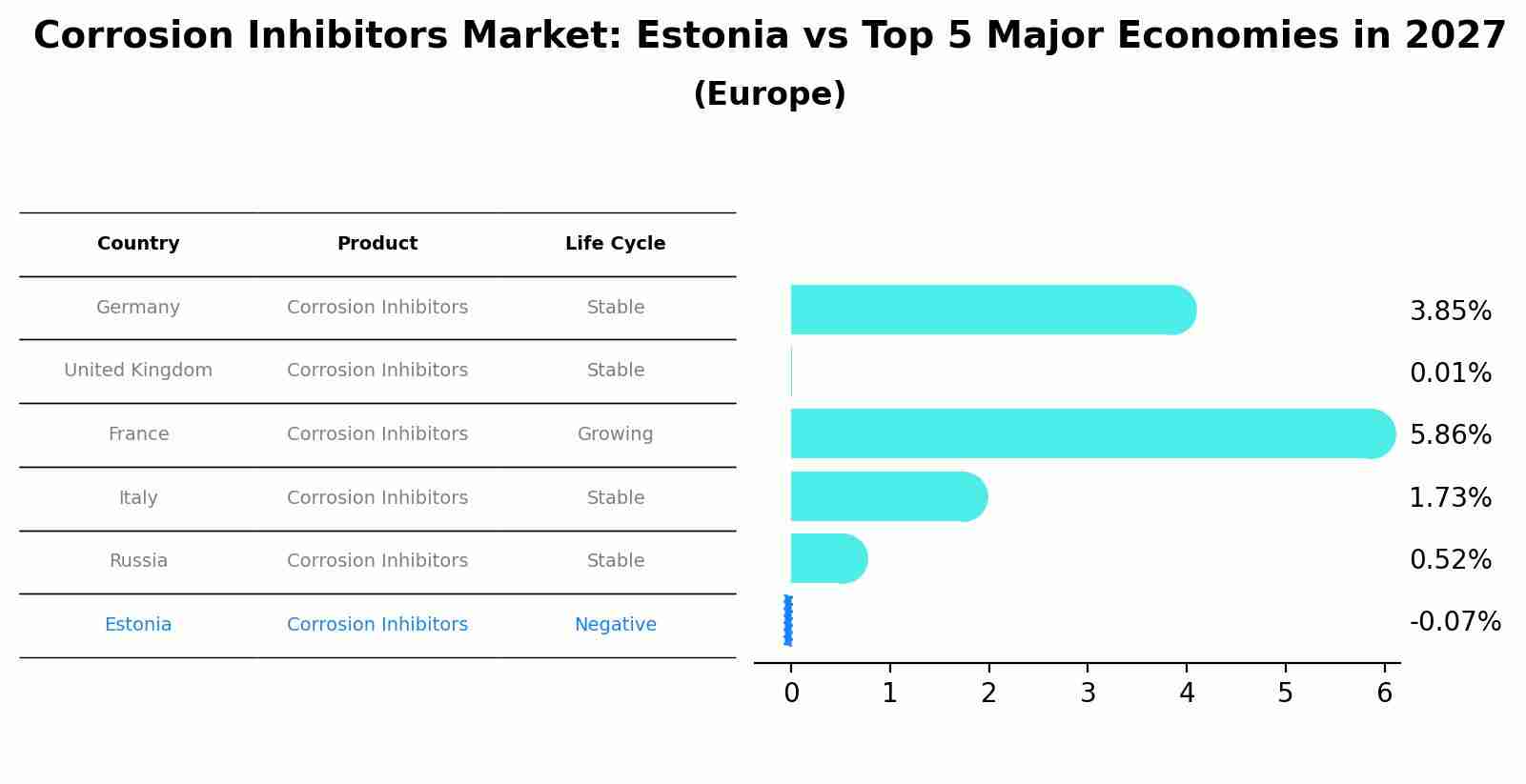Estonia Corrosion Inhibitors Market (2025-2031) | Industry, Companies, Size, Trends, Value, Analysis, Revenue, Outlook, Segmentation, Share, Growth & Forecast
| Product Code: ETC4665938 | Publication Date: Nov 2023 | Updated Date: Nov 2025 | Product Type: Market Research Report | |
| Publisher: 6Wresearch | Author: Shubham Deep | No. of Pages: 60 | No. of Figures: 30 | No. of Tables: 5 |
Estonia Corrosion Inhibitors Market Top 5 Importing Countries and Market Competition (HHI) Analysis
Estonia`s corrosion inhibitors import market saw a significant shift in concentration from 2023 to 2024, with a high Herfindahl-Hirschman Index (HHI) in the previous year giving way to lower concentration. The top countries exporting corrosion inhibitors to Estonia in 2024 were Finland, USA, Belgium, Other European countries, and Germany. Despite a negative compound annual growth rate (CAGR) of -25.66% from 2020 to 2024, the market experienced a notable growth spurt in 2024 with a growth rate of 40.62% compared to the previous year, indicating potential opportunities for market players.

Corrosion Inhibitors Market: Estonia vs Top 5 Major Economies in 2027 (Europe)
In the Europe region, the Corrosion Inhibitors market in Estonia is projected to expand at a negative growth rate of -0.07% by 2027. The largest economy is Germany, followed by United Kingdom, France, Italy and Russia.

Estonia Corrosion Inhibitors Market Overview
The corrosion inhibitors market in Estonia is seeing steady growth as industries increasingly recognize the importance of protecting equipment and infrastructure from the damaging effects of corrosion. These inhibitors are used in various applications, including in the automotive, oil and gas, and construction industries, to extend the lifespan of materials and reduce maintenance costs. As Estonias industrial sector continues to grow, particularly in manufacturing and infrastructure, the demand for corrosion inhibitors is expected to rise. Additionally, the market is benefitting from innovations in environmentally friendly inhibitors and sustainable materials.
Drivers of the market
The Estonia corrosion inhibitors market is growing due to the increasing need to protect metal structures, pipelines, and machinery from corrosion in industries such as oil and gas, automotive, and construction. The demand for durable and cost-effective corrosion protection solutions is driving the growth of this market.
Challenges of the market
The Estonia Corrosion Inhibitors Market faces increasing pressure to meet environmental and regulatory standards. Traditional corrosion inhibitors often contain harmful chemicals that are under scrutiny due to their potential environmental impact. This is leading to a shift toward eco-friendly and non-toxic alternatives, but the development and implementation of such products can be expensive. Moreover, the market is impacted by price volatility, as the raw materials used in corrosion inhibitors are subject to global supply chain fluctuations. Manufacturers must also deal with increased competition from global players, which may have more resources and better access to raw materials.
Government Policy of the market
The government supports the use of corrosion inhibitors to enhance industrial efficiency and infrastructure longevity. Policies emphasize environmental safety by encouraging the production of eco-friendly inhibitors.
Key Highlights of the Report:
- Estonia Corrosion Inhibitors Market Outlook
- Market Size of Estonia Corrosion Inhibitors Market, 2024
- Forecast of Estonia Corrosion Inhibitors Market, 2031
- Historical Data and Forecast of Estonia Corrosion Inhibitors Revenues & Volume for the Period 2021-2031
- Estonia Corrosion Inhibitors Market Trend Evolution
- Estonia Corrosion Inhibitors Market Drivers and Challenges
- Estonia Corrosion Inhibitors Price Trends
- Estonia Corrosion Inhibitors Porter`s Five Forces
- Estonia Corrosion Inhibitors Industry Life Cycle
- Historical Data and Forecast of Estonia Corrosion Inhibitors Market Revenues & Volume By Product for the Period 2021-2031
- Historical Data and Forecast of Estonia Corrosion Inhibitors Market Revenues & Volume By Organic for the Period 2021-2031
- Historical Data and Forecast of Estonia Corrosion Inhibitors Market Revenues & Volume By Inorganic for the Period 2021-2031
- Historical Data and Forecast of Estonia Corrosion Inhibitors Market Revenues & Volume By Type for the Period 2021-2031
- Historical Data and Forecast of Estonia Corrosion Inhibitors Market Revenues & Volume By Water Based for the Period 2021-2031
- Historical Data and Forecast of Estonia Corrosion Inhibitors Market Revenues & Volume By Oil Based for the Period 2021-2031
- Historical Data and Forecast of Estonia Corrosion Inhibitors Market Revenues & Volume By End-use for the Period 2021-2031
- Historical Data and Forecast of Estonia Corrosion Inhibitors Market Revenues & Volume By Power Generation for the Period 2021-2031
- Historical Data and Forecast of Estonia Corrosion Inhibitors Market Revenues & Volume By Oil & Gas for the Period 2021-2031
- Historical Data and Forecast of Estonia Corrosion Inhibitors Market Revenues & Volume By Paper & Pulp for the Period 2021-2031
- Historical Data and Forecast of Estonia Corrosion Inhibitors Market Revenues & Volume By Metal Processing for the Period 2021-2031
- Historical Data and Forecast of Estonia Corrosion Inhibitors Market Revenues & Volume By Chemical Processing for the Period 2021-2031
- Historical Data and Forecast of Estonia Corrosion Inhibitors Market Revenues & Volume By Water Treatment for the Period 2021-2031
- Historical Data and Forecast of Estonia Corrosion Inhibitors Market Revenues & Volume By Others for the Period 2021-2031
- Estonia Corrosion Inhibitors Import Export Trade Statistics
- Market Opportunity Assessment By Product
- Market Opportunity Assessment By Type
- Market Opportunity Assessment By End-use
- Estonia Corrosion Inhibitors Top Companies Market Share
- Estonia Corrosion Inhibitors Competitive Benchmarking By Technical and Operational Parameters
- Estonia Corrosion Inhibitors Company Profiles
- Estonia Corrosion Inhibitors Key Strategic Recommendations
Frequently Asked Questions About the Market Study (FAQs):
1 Executive Summary |
2 Introduction |
2.1 Key Highlights of the Report |
2.2 Report Description |
2.3 Market Scope & Segmentation |
2.4 Research Methodology |
2.5 Assumptions |
3 Estonia Corrosion Inhibitors Market Overview |
3.1 Estonia Country Macro Economic Indicators |
3.2 Estonia Corrosion Inhibitors Market Revenues & Volume, 2021 & 2031F |
3.3 Estonia Corrosion Inhibitors Market - Industry Life Cycle |
3.4 Estonia Corrosion Inhibitors Market - Porter's Five Forces |
3.5 Estonia Corrosion Inhibitors Market Revenues & Volume Share, By Product, 2021 & 2031F |
3.6 Estonia Corrosion Inhibitors Market Revenues & Volume Share, By Type, 2021 & 2031F |
3.7 Estonia Corrosion Inhibitors Market Revenues & Volume Share, By End-use, 2021 & 2031F |
4 Estonia Corrosion Inhibitors Market Dynamics |
4.1 Impact Analysis |
4.2 Market Drivers |
4.3 Market Restraints |
5 Estonia Corrosion Inhibitors Market Trends |
6 Estonia Corrosion Inhibitors Market Segmentations |
6.1 Estonia Corrosion Inhibitors Market, By Product |
6.1.1 Overview and Analysis |
6.1.2 Estonia Corrosion Inhibitors Market Revenues & Volume, By Organic, 2021-2031F |
6.1.3 Estonia Corrosion Inhibitors Market Revenues & Volume, By Inorganic, 2021-2031F |
6.2 Estonia Corrosion Inhibitors Market, By Type |
6.2.1 Overview and Analysis |
6.2.2 Estonia Corrosion Inhibitors Market Revenues & Volume, By Water Based, 2021-2031F |
6.2.3 Estonia Corrosion Inhibitors Market Revenues & Volume, By Oil Based, 2021-2031F |
6.3 Estonia Corrosion Inhibitors Market, By End-use |
6.3.1 Overview and Analysis |
6.3.2 Estonia Corrosion Inhibitors Market Revenues & Volume, By Power Generation, 2021-2031F |
6.3.3 Estonia Corrosion Inhibitors Market Revenues & Volume, By Oil & Gas, 2021-2031F |
6.3.4 Estonia Corrosion Inhibitors Market Revenues & Volume, By Paper & Pulp, 2021-2031F |
6.3.5 Estonia Corrosion Inhibitors Market Revenues & Volume, By Metal Processing, 2021-2031F |
6.3.6 Estonia Corrosion Inhibitors Market Revenues & Volume, By Chemical Processing, 2021-2031F |
6.3.7 Estonia Corrosion Inhibitors Market Revenues & Volume, By Water Treatment, 2021-2031F |
7 Estonia Corrosion Inhibitors Market Import-Export Trade Statistics |
7.1 Estonia Corrosion Inhibitors Market Export to Major Countries |
7.2 Estonia Corrosion Inhibitors Market Imports from Major Countries |
8 Estonia Corrosion Inhibitors Market Key Performance Indicators |
9 Estonia Corrosion Inhibitors Market - Opportunity Assessment |
9.1 Estonia Corrosion Inhibitors Market Opportunity Assessment, By Product, 2021 & 2031F |
9.2 Estonia Corrosion Inhibitors Market Opportunity Assessment, By Type, 2021 & 2031F |
9.3 Estonia Corrosion Inhibitors Market Opportunity Assessment, By End-use, 2021 & 2031F |
10 Estonia Corrosion Inhibitors Market - Competitive Landscape |
10.1 Estonia Corrosion Inhibitors Market Revenue Share, By Companies, 2024 |
10.2 Estonia Corrosion Inhibitors Market Competitive Benchmarking, By Operating and Technical Parameters |
11 Company Profiles |
12 Recommendations | 13 Disclaimer |
- Single User License$ 1,995
- Department License$ 2,400
- Site License$ 3,120
- Global License$ 3,795
Search
Thought Leadership and Analyst Meet
Our Clients
Related Reports
- Afghanistan Apparel Market (2026-2032) | Growth, Outlook, Industry, Segmentation, Forecast, Size, Companies, Trends, Value, Share, Analysis & Revenue
- Canada Oil and Gas Market (2026-2032) | Share, Segmentation, Value, Industry, Trends, Forecast, Analysis, Size & Revenue, Growth, Competitive Landscape, Outlook, Companies
- Germany Breakfast Food Market (2026-2032) | Industry, Share, Growth, Size, Companies, Value, Analysis, Revenue, Trends, Forecast & Outlook
- Australia Briquette Market (2025-2031) | Growth, Size, Revenue, Forecast, Analysis, Trends, Value, Share, Industry & Companies
- Vietnam System Integrator Market (2025-2031) | Size, Companies, Analysis, Industry, Value, Forecast, Growth, Trends, Revenue & Share
- ASEAN and Thailand Brain Health Supplements Market (2025-2031) | Strategy, Consumer Insights, Analysis, Investment Trends, Opportunities, Growth, Size, Share, Industry, Revenue, Segments, Value, Segmentation, Supply, Forecast, Restraints, Outlook, Competition, Drivers, Trends, Demand, Pricing Analysis, Competitive, Strategic Insights, Companies, Challenges
- ASEAN Bearings Market (2025-2031) | Strategy, Consumer Insights, Analysis, Investment Trends, Opportunities, Growth, Size, Share, Industry, Revenue, Segments, Value, Segmentation, Supply, Forecast, Restraints, Outlook, Competition, Drivers, Trends, Demand, Pricing Analysis, Competitive, Strategic Insights, Companies, Challenges
- Europe Flooring Market (2025-2031) | Outlook, Share, Industry, Trends, Forecast, Companies, Revenue, Size, Analysis, Growth & Value
- Saudi Arabia Manlift Market (2025-2031) | Outlook, Size, Growth, Trends, Companies, Industry, Revenue, Value, Share, Forecast & Analysis
- Uganda Excavator, Crane, and Wheel Loaders Market (2025-2031) | Strategy, Consumer Insights, Analysis, Investment Trends, Opportunities, Growth, Size, Share, Industry, Revenue, Segments, Value, Segmentation, Supply, Forecast, Restraints, Outlook, Competition, Drivers, Trends, Demand, Pricing Analysis, Competitive, Strategic Insights, Companies, Challenges
Industry Events and Analyst Meet
Whitepaper
- Middle East & Africa Commercial Security Market Click here to view more.
- Middle East & Africa Fire Safety Systems & Equipment Market Click here to view more.
- GCC Drone Market Click here to view more.
- Middle East Lighting Fixture Market Click here to view more.
- GCC Physical & Perimeter Security Market Click here to view more.
6WResearch In News
- Doha a strategic location for EV manufacturing hub: IPA Qatar
- Demand for luxury TVs surging in the GCC, says Samsung
- Empowering Growth: The Thriving Journey of Bangladesh’s Cable Industry
- Demand for luxury TVs surging in the GCC, says Samsung
- Video call with a traditional healer? Once unthinkable, it’s now common in South Africa
- Intelligent Buildings To Smooth GCC’s Path To Net Zero


















